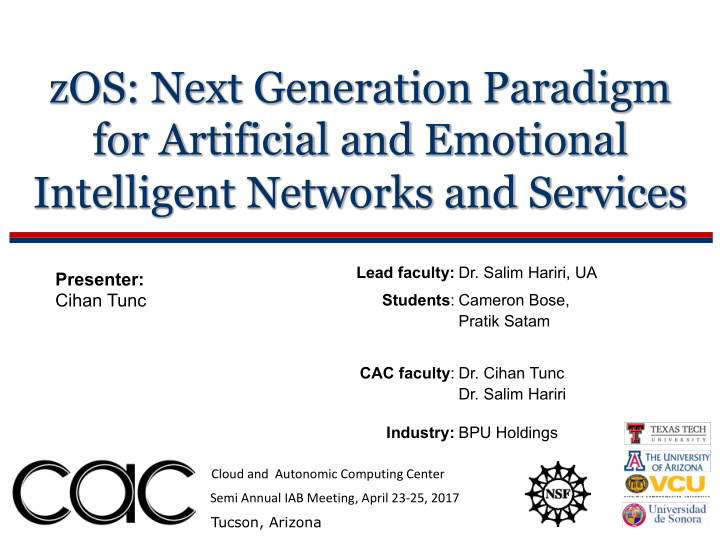



zOS: Next Generation Paradigm for Artificial and Emotional Intelligent Networks and Services Lead faculty: Dr. Salim Hariri, UA Presenter: Cihan Tunc Students : Cameron Bose, Pratik Satam CAC faculty : Dr. Cihan Tunc Dr. Salim Hariri Industry: BPU Holdings Cloud and Autonomic Computing Center Semi Annual IAB Meeting, April 23-25, 2017 Tucson, Arizona
Outline Project Goals, Motivations Project Overview Project team members Background and Related Research Overview of project tasks Activities and outcomes Deliverables and benefits LIFE form input
Project Team Members Faculty Dr. Salim Hariri Director, CAC Director & ECE Department, The University of Arizona Dr. Cihan Tunc Research Assistant Professor, ECE Department, The University of Arizona Students Cameron Bose BSc student, The University of Arizona Pratik Satam PhD student, The University of Arizona
Project Goals, Motivation Motivation Smart devices are proliferating with the promise to make human lives better Large set of smart wearables: phones, watches, glasses, etc. The machines are monitoring almost every aspect of our lives Problems arise because these technologies use proprietary underlying infrastructure that enforces brand controls Current control and management technologies are incapable to manage and secure such complex, dynamic infrastructures and services
Project Goals, Motivation Goal Primary goal is to empower the human Unification technology that reduces the proliferation of personally identifiable information Introduce a new model where people manage their own information, not Facebook or Google, or some other company Machines, hardware or software can comply, cooperate or be firewalled by intelligent proxies Using AI technology to learn and understand emotional patterns to assist human-coached decisions Providing services to help daily life
zOS architecture 6
zOS Application
zOS Application § Create a smart zOS based backup system using voice commands § Can be partially on cloud & partially on the device Cloud Environment zOS
zOS Application 9
zOS Application 10
zOS System Footprint § A system can be considered as a tuple as !"#$%& = { '()*+()% , !,-$+()% , .,/-012)($0,/ } § We can create a device specific unique ID using the system definition as § Hardware specific information: § MAC § CPU information § Software specific information: § Active services § Kernel § Configurations: § Users and their passwords § Boot configuration
zOS boot-up time integrity check Decrypt & Run Success Hardware attributes System Key Obfuscator Encryption/ generator Decryption Software Failure attributes Shutdown Boot-up time system integrity check
zOS System Registration Step 0: Create zOS system § Step 1: Create KP1 and KP2 and keep the PUB keys on zOS and PRI keys on- § house Step 2: zOS creates AF § Step 3: zOS contacts LS with AF (encrypted with PUB2) § Step 4: DigitalMe servers generates LC using AF with PRI1 § LC = AF + Capabilities + Time info + Signature (using PRI1) Step 5: DigitalMe uploads LC to LS and AS through HTTPS §
zOS License Check § Step 1: Get time information from LS (can be encrypted using KP3) § Step 2: Using PUB1, validate signature (through RSA) in ThinPad (AS) § Valid license? Continue operation. § License expired? Buy license § License invalid? Shutdown system
zOS Environment Setup § Create AEIOS environment § Task 1.a – 3 Raspberry Pi will be used for thin-tech POD § Task 1.b – A cloud environment will be created for the application deployment § VM from Amazon or ACL private cloud Cloud Environment
zOS Voice Interface Setup § Include speech recognition & voice to text § Open source tools: CMUSphinx, Mozilla Speech Recognition, Kaldi, Simon, etc. § Commercial tools, e.g. Google API zOS
Milestones and Deliverables for 2018 Milestones for the current proposed year: p Q1: Building the framework, including registration & licensing system together with footprint p Q2-Q3: Creating speech recognition & voice based service oriented commands and creating thin-pads to be used for the personal assistant p Q4: Building proof-of-concept environment Deliverables for the current proposed year: (1) Expanding framework; (2) Improving the personal assistant capabilities and connecting to the services; (3) Various services; (4) Public reports or publications.
Potential Member Company Benefits Expected benefits to members and other CAC projects include: • Creating the next-gen open-source middleware/OS • Help community through services such as • Digital Patient Assistant • Digital IT Assistant • Know-how on how to enhance the living environments
LIFE Form Input Please take a moment to fill out your L.I.F.E. forms. http://www.iucrc.com Select “Cloud and Autonomic Computing Center” then select “IAB” role. What do you like about this project? What would you change? (Please include all relevant feedback.) 19
Recommend
More recommend